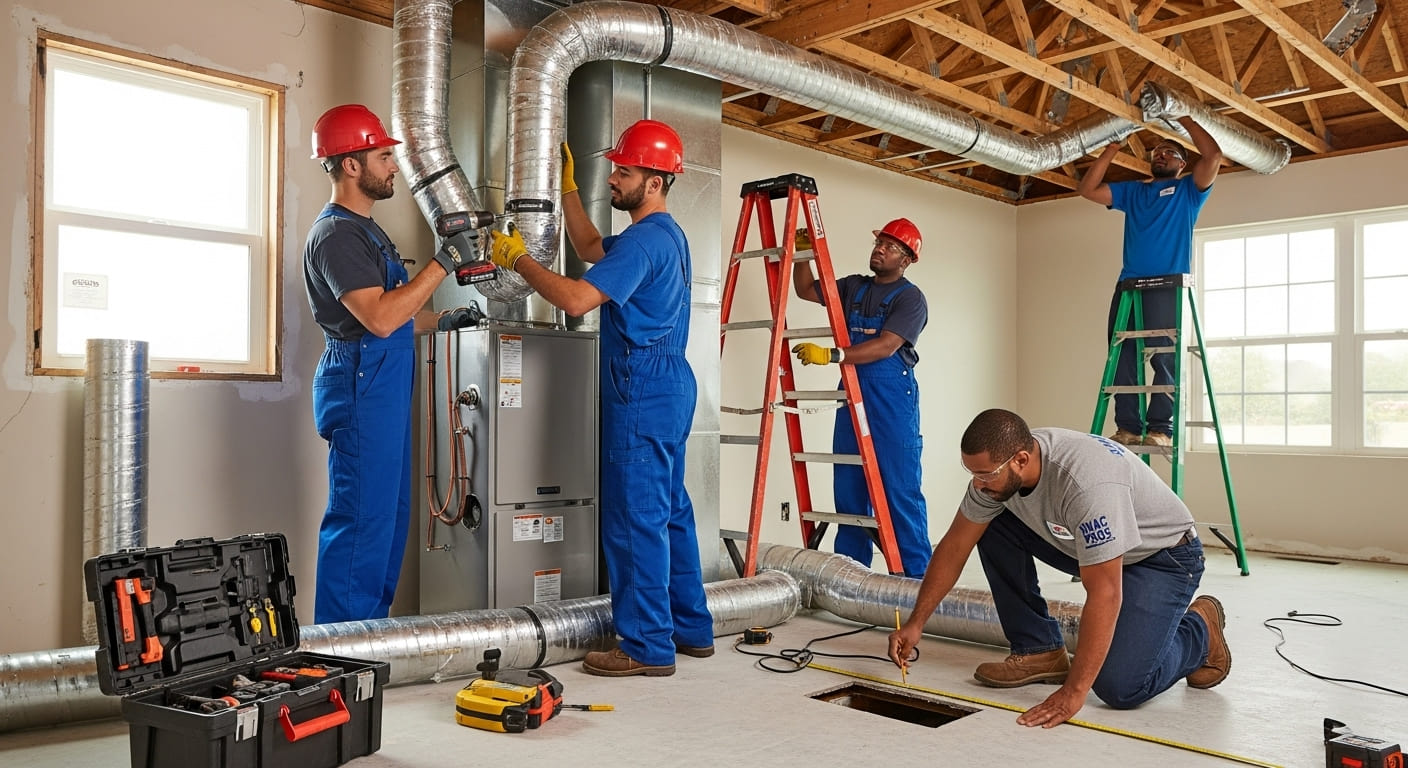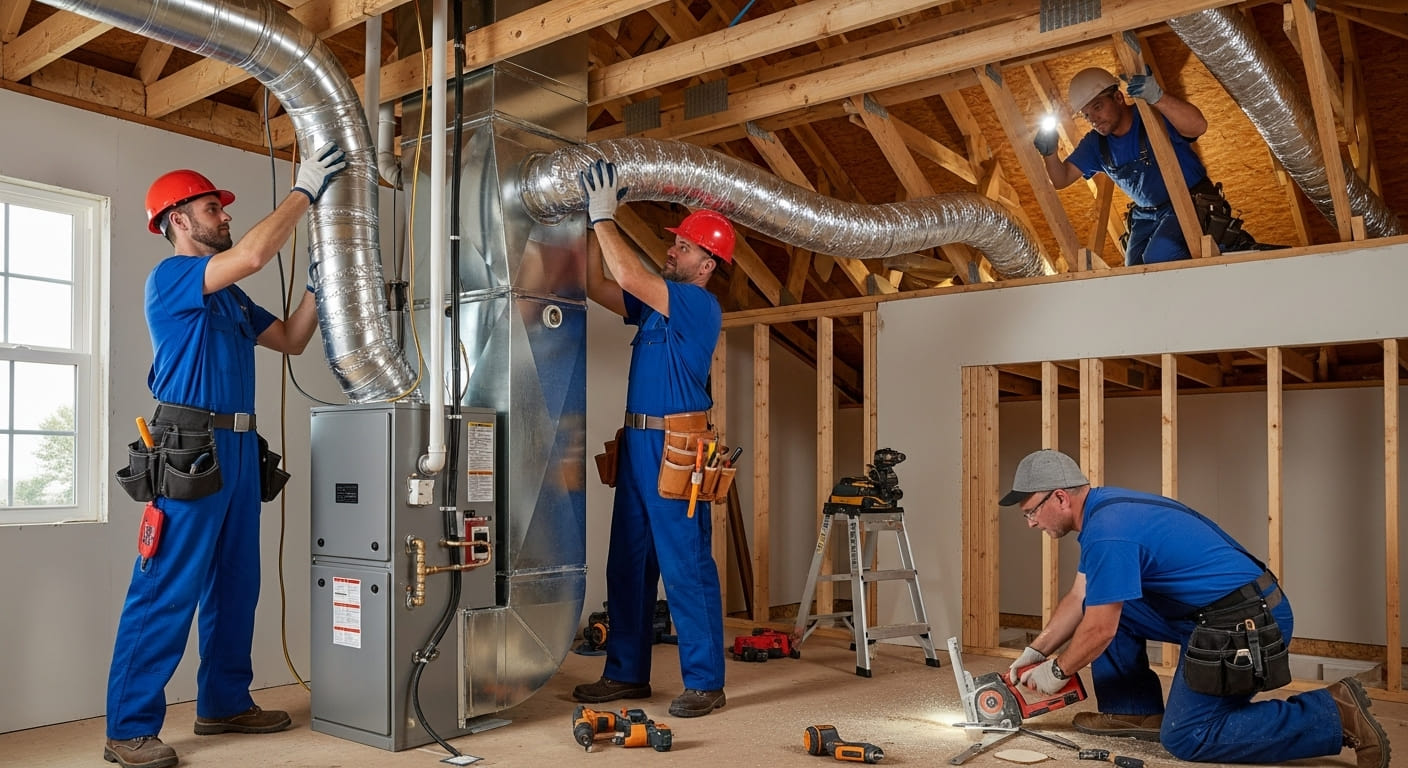You ever wake up to a chilly Melbourne morning and wish for that even warmth spreading through the house without cranking up a bunch of heaters? That’s the charm of a duct heating system—it’s like having an invisible blanket that warms every room quietly and efficiently. Here in Australia with our crisp winters in the south and milder chills up north a duct heating system fits right into our homes where we want comfort without the fuss. I’ve talked to a few folks who’ve switched from old electric blankets or spot heaters and they rave about how it changes the feel of the place. Whether you’re in a cozy bungalow in the suburbs or a larger family home in the Dandenongs this guide covers everything from how a duct heating system works to installation tips maintenance advice and local Melbourne factors like our variable weather. Let’s explore why a duct heating system might be the upgrade your home needs for those cozy nights in.
Table of Contents
What a Duct Heating System Is and How It Fits Your Home
A duct heating system warms your space by pushing hot air through a network of ducts hidden in walls ceilings or floors. The core unit heats the air then a fan circulates it to vents in each room. It’s different from wall units because it covers the whole house evenly. In Melbourne homes a duct heating system handles our cool snaps without drying the air like some radiators do.
From what I’ve gathered from homeowners a duct heating system ties into our love for open living. You get consistent warmth from the lounge to the bedrooms without hot spots or cold corners. It’s often gas-powered for quick heat or electric for cleaner runs. A friend in Camberwell installed one during a reno. The even flow made his open-plan kitchen cozy without blasting one spot. Related features like zoning controls let you heat just the living areas at night saving energy. In Australia’s diverse climates from Hobart’s frosts to Perth’s mild winters a duct heating system adapts well keeping things comfortable year-round.
How a Duct Heating System Actually Works
The system starts with a heat source in the central unit. Gas burns to warm air or electric elements do the job. A blower then pushes it through insulated ducts to outlets. Return vents pull cooler air back for reheating. It’s a closed loop that recycles air efficiently.
In Melbourne’s variable days a duct heating system responds fast to drops in temperature. Filters trap dust so the air stays clean. Modern ones add humidity control to avoid dry skin in heated homes. Understanding this helps you see why proper duct heating system installation matters for smooth operation.
Main Parts of a Duct Heating System
The central unit houses the burner fan and heat exchanger. Ducts are the pipes carrying warm air. Vents release it into rooms. Return grilles suck air back. Insulation wraps ducts to hold heat. Thermostats control temps. During duct heating system installation each part connects precisely. Wrong duct size slows flow. I helped a pal in Box Hill check his. Weak insulation let heat escape raising bills. Knowing the parts lets you ask about sealing or sizing.
Why Choose a Duct Heating System for Australian Homes
A duct heating system offers real advantages especially in our cooler months. Let’s look at the top reasons it stands out.
Energy Savings and Cost Benefits
A duct heating system uses less energy than multiple room heaters. Gas models heat fast with lower running costs around $0.50 per hour for a 150m² home. In Melbourne where winters bite a duct heating system paired with insulation cuts bills by 20-30%. Rebates from Victoria’s energy programs add $500-1,000 off installs.
A neighbor in Doncaster switched from electric panels. His quarterly gas bill dropped $200. Compared to reverse cycle air con a duct heating system warms quicker without cooling side effects. Long-term it pays back in 3-5 years through efficiency.

Comfort and Even Heating Across Rooms
Unlike spot heaters a duct heating system spreads warmth uniformly. No more cold bedrooms while the lounge roasts. Zoning lets you adjust per area saving energy in unused spaces. In family homes like those in the Yarra Valley a duct heating system keeps kids’ rooms toasty without overdoing the main area.
Humidity stays balanced too avoiding dry air issues. A friend in Frankston loves how his duct heating system quiets the house—no fan whirs in every room. It fits our casual living where we gather in open spaces.
Durability and Low Maintenance Needs
Built tough a duct heating system lasts 15-25 years with basic care. Galvanized ducts resist rust in coastal Melbourne spots like Port Phillip. Annual filter changes and vent cleans keep it running smooth costing $100-200 yearly.
In dusty inland areas like the Mallee reinforced filters extend life. Compared to hydronic systems a duct heating system installs easier with less upfront cost. Example: A household in Mornington Peninsula had theirs for 20 years with just routine checks—no major breakdowns.
Types of Duct Heating Systems to Consider
Australia offers a few duct heating system options each suited to different needs.
Gas Duct Heating Systems for Quick Warmth
Gas models heat air fast using natural gas or LPG. They’re common in Melbourne for reliable winter performance. Output ranges 15-40kW for small to large homes. Pros include low running costs and even distribution. A gas duct heating system suits connected homes with $0.03-0.05 per MJ rates.
Downsides? Needs venting and annual safety checks. In Victoria gas duct heating systems qualify for rebates if efficient. A Camberwell family chose gas for their 200m² home. It warmed up in 10 minutes beating electric alternatives.
Electric Duct Heating Systems for Cleaner Options
Electric uses elements to warm air ideal for all-electric homes or off-grid setups. They’re simpler to install without gas lines. In Melbourne’s suburbs electric duct heating systems pair with solar for low bills.
Efficiency reaches 100% but higher power rates mean $0.30/kWh costs. Good for smaller spaces under 150m². A friend in Bayswater went electric with panels. It integrated seamlessly with his battery storage.
Hydronic vs. Ducted: Quick Comparison
Hydronic heats water for radiators—slower but silent. Ducted air heats quicker with better distribution. For Melbourne hydronic suits renovations while duct heating system installation fits new builds. Costs hydronic $15,000-25,000 ducted $8,000-15,000.
Choose duct for even flow in open plans.
Step-by-Step Guide to Duct Heating System Installation
Installing a duct heating system takes planning but rewards with cozy winters.
Pre-Installation Planning Essentials
Measure home layout for duct runs. Calculate load with pros—factor insulation and windows. In Melbourne get council nods for gas lines if needed. Budget $8,000-15,000 including labor.
Check zoning for room balance. A tip: Sketch vents to avoid awkward spots.
The Installation Process Breakdown
Day 1: Site prep and unit placement. Core unit goes in utility space. Run ducts through ceiling or floor. Seal joints with mastic.
Day 2-3: Connect vents returns and wiring. Electric simple gas needs venting. Test blower and heat exchanger.
Day 4: Balance flow with dampers. Run full cycles check temps. In Melbourne insulate ducts for cold snaps.
Example: A Ringwood home install took four days. Crew sealed runs tight. Even heat from lounge to bedrooms.
Post-Installation Testing and Adjustments
Run system 24 hours monitor temps. Adjust dampers for balance. Clean filters. Pros provide handover with manual.
In humid summers check for moisture buildup.
Maintenance Tips to Keep Your Duct Heating System Running Strong
Regular care extends life and efficiency.
Daily and Weekly Checks
Ventilate rooms to avoid stuffiness. Wipe dust from grilles. In Melbourne pollen season clean filters weekly.
Seasonal and Annual Upkeep
Spring: Deep clean ducts $300-500. Winter: Check gas pressure. Annual pro service $150-300 includes safety certs.
In coastal areas rinse salt from vents quarterly. A Bayside home neglected filters. Dust built up cutting flow 20%.
Troubleshooting Common Issues
Uneven heat? Balance dampers. Noises? Tighten braces. Low output? Clean exchanger. Call pros for gas leaks.
Melbourne-Specific Factors for Duct Heating Systems
Our climate and rules shape duct heating system choices.
Local Regulations and Compliance
AS/NZS 5601 for gas installs. Victoria requires licensed gasfitters. Fines $10,000 for non-compliance. Melbourne councils check venting for noise under 5dB.
Heritage homes in Kew need subtle ducts. Providers offer compliant kits.
Weather and Home Design Considerations
Melbourne’s colds demand 20kW+ for 150m². Insulate for efficiency. Coastal salt corrodes—use galvanized. Bush areas like the Dandenongs need fire-rated ducts.
Cultural note: In multicultural suburbs like Dandenong duct heating system zoning suits diverse family needs.
Questions and Answers: Common Questions About Duct Heating System in Melbourne
Q: How do I size a duct heating system for Melbourne winters?
Heat load calc factors home size insulation windows. Melbourne colds add 20%. Pros free assess to avoid $600 yearly overages.
Q: What’s the install cost for duct heating system in Melbourne homes?
$8,000-15,000 includes unit ducts labor. Melbourne permits $300 extra. Quotes for compliance skip $1,500 fixes.
Q: How long does duct heating system installation take in Melbourne?
3-5 days. Older homes need duct routing. Melbourne tight spaces careful bracing. Book off-peak avoid disruption.
Q: Are rebates available for duct heating system in Melbourne?
Victorian programs $500-1,200 efficient models. Melbourne gas fits climate. Check Sustainability Victoria eligibility.
Q: What maintenance follows duct heating system installation in Melbourne?
Monthly filter cleans annual service $200. Melbourne dust clogs quick. Proper install reduces needs monitor for leaks in moist winters.
Conclusion: Your Path to a Successful Duct Heating System in Australia
Duct heating system delivers uniform warmth for our temperate climates avoiding errors like sizing or sealing to lower $600-3,000 yearly expenses and repairs. We’ve reviewed fundamentals from components to common mistakes like duct leaks preparation with loads and Melbourne weather essential steps like balancing and mounting legal AS/NZS guidelines and installer choices with Gas Safe credentials. In our residence-focused ethos duct heating system installation blends tech with routine simplicity from coastal shielding to suburban circulation.
To succeed evaluate your design secure expert evaluation verify credentialed RACCA installers require launch budget $8,000-15,000 claim incentives uphold monthly. Examine flows after setup. With considerate duct heating system installation you’ll acquire consistent heat diminished bills tranquility suited Aussie residences.

